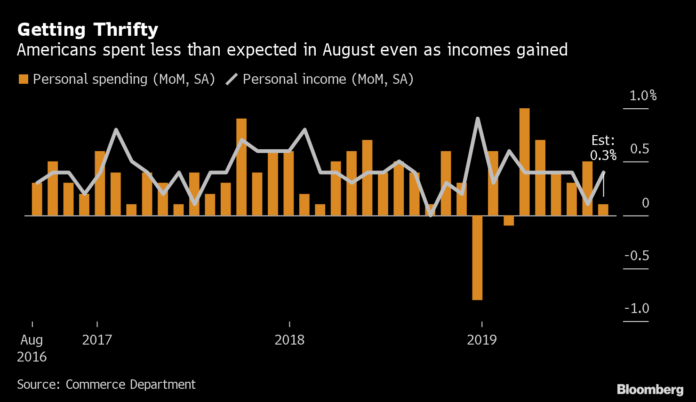WASHINGTON – The United States economy cooled in August as Americans spent less than projected and companies cut capital-equipment orders, with below-forecast prices and lukewarm consumer sentiment adding to concerns that may support the case for further Federal Reserve easing.
Consumer spending on goods and services, which accounts for about two-thirds of gross domestic product, increased 0.1% from July, the smallest gain in six months, Commerce Department data showed Friday. The Fed’s preferred underlying price gauge rose 0.1% from July, missing the median 0.2% estimate, while the gain in incomes matched projections.
“The consumer is still in solid shape and the quarter’s still going to be good, but we were shaping up initially for a spectacular quarter, and I think we probably need to temper expectations a little bit,” said Stephen Stanley, chief economist at Amherst Pierpont Securities.
A separate Commerce Department report showed bookings for nonmilitary capital goods excluding aircraft – a proxy for business investment – fell 0.2%, the weakest performance in four months, compared with forecasts for no change. Elsewhere, the University of Michigan’s consumer sentiment survey showed improvement in late September while remaining subdued after an August plunge.
The data suggest more moderate economic growth in the third quarter, adding focus to next week’s September jobs report to show whether the labor-market slowdown is deepening. At the same time, solid income gains and a still-healthy employment should keep supporting consumption and extend the record-long U.S. expansion in coming months, as wages and salaries posted the biggest increase since March.
“August personal-spending growth decelerated to the slowest pace since February. This suggests personal consumption, the key driver of GDP growth at present, will slow in the current quarter from the stellar pace registered in the second quarter. It will nonetheless remain strong enough to sustain economic growth close to potential in the second half of the year,” Bloomberg economists Yelena Shulyatyeva and Carl Riccadonna said.
Last week, Fed officials cut the benchmark interest rate by a quarter point for the second time in two months to protect the economy from global weakness and trade uncertainty. Central bankers’ quarterly forecasts signaled only a minority of officials saw the need to lower borrowing costs further this year.
“Business investment has kind of fallen off of a cliff,” Fed Gov. Randal Quarles said in remarks Friday in Washington. “That’s a concern, but not one which affects the fundamental soundness of the current position of the economy.”
Still, the trend in nonmilitary capital goods orders underscores how the U.S.-China trade war and slowing growth abroad are weighing on American companies. Policy uncertainty has muddled supply chains and contributed to delayed long-term investments in people and capital. The question is how much the weakness will filter through to the broader economy.
The business-equipment data reflect an escalation of tariff threats by President Donald Trump in August, but September figures will offer a fuller picture of the impact of the duties that went into effect Sept. 1. Nonresidential investment, which includes corporate outlays for structures, contracted in the second quarter for the first time since 2016.
“You’ve got this huge dichotomy between the domestic economy – driven mainly by the consumer – on one side that’s doing well, and then the piece of the economy that’s exposed to the global situation and to trade has really taken it on the chin,” Stanley said.
The core personal consumption expenditures price index, which excludes food and energy, increased 1.8% from August of last year, matching estimates though the monthly figure was below forecast. The annual gain was the largest since January, offering some comfort to policy makers, who view the core gauge as a better indicator of underlying price trends.
The broader PCE price gauge, which the Fed officially targets for 2% inflation, was unchanged from the prior month – missing estimates for a gain – and rose 1.4% from a year earlier, matching the median projection in a Bloomberg survey.
Muted inflationary pressures have vexed policy makers throughout the expansion, and price gains remain relatively subdued despite a tight labor market and faster wage increases. Trump has cited low inflation as an argument for more aggressive rate cuts by the Fed.
After adjusting for the increase in inflation, spending also rose 0.1%. The gain in August was driven by recreational goods and vehicles, while services spending was little changed amid a decline in outlays on food services and accommodations.
The personal saving rate rose to 8.1% from 7.8% the prior month. Adjusted for inflation, disposable income was up 0.4% following no change.
The broader measure of bookings for all durable goods, or items meant to last at least three years, topped estimates with a 0.2% gain, as defense capital-goods orders rose the most since March.
Shipments of non-defense capital goods excluding aircraft – a measure used in GDP calculations – rose 0.4% following a 0.6% drop. The report showed the three-month annualized gain for business-equipment shipments fell to 0.5% from 0.9%, while it rose to 2.6% from 0.9% for orders, suggesting business investment remains muted.
Reade Pickert is a reporter for Bloomberg News.













